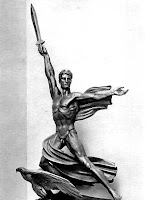 |
| © Copyright Peter Crawford 2013 |
'All is race - there is no other truth."
Benjamin Disraeli
Race has been described as 'the family writ large', and yet no word in the modern Western parlance is as scary as the word ‘race’.
It is avoided like the plague by contemporary opinion makers, except when they use its verbal derivative “racist” against right-wingers, 'white nationalists', ‘neo-Nazis’ and their proverbial bed fellows ‘'anti-Semites'.
 |
| Der Geist des Rasse © Copyright Peter Crawford 2013 |
As professor Daniel A. Beach recently noted: “Race pervades a great deal of social and interpersonal issues with which we must contend, yet we have no effective way of talking about it.”
Unlike their colleagues in the social sciences, many Western biologists and geneticists are well aware of differences among races, yet they prefer to resort to esoteric verbiage and expressions, such as “mapping the genome,” or “different gene pools” or “different haplotypes,” when doing research on the subject of race.
In biological classification, race is identical with the term 'subspecies' (abbreviated "subsp." or "ssp."; plural: "subspecies"), and is either a taxonomic rank subordinate to species, or a taxonomic unit in that rank.
A subspecies cannot be recognized in isolation: a species will either be recognized as having no subspecies at all, or two or more (including any that are extinct), but never just one.
Organisms that belong to different subspecies of the same species are capable of interbreeding and producing fertile offspring, but they often do not interbreed in nature, due to geographic isolation, or other factors.
The differences between subspecies are usually less distinct than the differences between species.
The characteristics attributed to subspecies generally have evolved as a result of geographical distribution or isolation.
A 'subspecies' is identical with the term 'breed', as is found in domesticated animals.
The characteristics attributed to subspecies generally have evolved as a result of geographical distribution or isolation.
A 'subspecies' is identical with the term 'breed', as is found in domesticated animals.
Die Semantik der Rasse
 |
| © Copyright Peter Crawford 2014 |
The etymology of the word ‘race’ is still unclear, although most likely it derives from the old Latin word ‘radix,’ meaning roots, or the German ‘reiza,' meaning family lineage.
Its significance became ideologically loaded only in the late 1920s.
Over the last 50 years, it has undergone a total semantic distortion.
Its significance became ideologically loaded only in the late 1920s.
Over the last 50 years, it has undergone a total semantic distortion.
The concept of 'eugenics' is now associated with National Socialism, and has come to be understood, among the 'so called' educated classes, as the epitome of evil.
In fact, however, eugenic measures were a standard family practice from time immemorial among European tribes.
Undoubtedly, each family had to be prolific, with a multitude of children able to work on the land or to guard the household.
This meant allowing, and frequently facilitating, the death of children who were sickly, or had disabilities.
Undoubtedly, each family had to be prolific, with a multitude of children able to work on the land or to guard the household.
This meant allowing, and frequently facilitating, the death of children who were sickly, or had disabilities.
Until recently in the European countryside when a young girl and boy were about to start dating, parents first inquired about whether their respective fathers or mothers were alcoholics, whether somebody in their family tree had some serious illness, such as diabetes, tuberculosis, or some nervous disorder - or even inborn proclivity to criminal behavior.
A semi-literate, yet intelligent European peasant or farmer did not have to be versed in socio-biology, or have a degree in molecular biology, in order to realize that hereditary diseases of the unfortunate partner could easily be transmitted to the newborns, with deadly social consequences for the entire family.
A semi-literate, yet intelligent European peasant or farmer did not have to be versed in socio-biology, or have a degree in molecular biology, in order to realize that hereditary diseases of the unfortunate partner could easily be transmitted to the newborns, with deadly social consequences for the entire family.
In France it is still common to hear the expression “elle est de bonne race” (“she is of good breed or character”) for a good looking and healthy woman.
In the Croatian or the Serbian language one can hear among young adults the colloquial adjective ‘rasna’ (‘raceful’), when depicting a good and healthy looking person.
In such particular instances ‘race’ is a synonym of good health and good looks.
In a more formal sense, race has been described as a 'classification system', used to categorize humans into large and distinct populations or groups, by heritable phenotypic characteristics, geographic ancestry, physical appearance, and ethnicity.
There are often differences unique to each racial population.
Academic studies of race in the 19th and 20th centuries led to the modern concept of the 'Aryan Herrenrasse' (Aryan Master Race), which posited a hierarchy of races based on darkness of skin color, eye and hair color, and certain skeletal features, and in particular the proportions of skulls.
Nevertheless, such theorists usually accepted that considerable variety of hair and eye color existed even within the racial categories they recognized.
Contrary to the popular 'urban myth', the German National Socialists did not discriminate against those who did not have blond hair or light-eyes, or had only one of these features.
Adolf Hitler and many other National Socialist officials had dark hair, and were still considered to be a Aryan.
(The term Aryan derives from the Sanskrit word (a´rya), which derived from arya, the original Indo-Iranian autonym meaning 'noble')
The postulated superiority of these people was said to make them born leaders, and hence to appellation "Herrenrasse" - (Master-race)
(it is important that 'Herrenrasse' should not be confused with the term 'Ubermensch' - the former is the precursor of the latter.)
After 1945, however, everything changed.
In the Croatian or the Serbian language one can hear among young adults the colloquial adjective ‘rasna’ (‘raceful’), when depicting a good and healthy looking person.
In such particular instances ‘race’ is a synonym of good health and good looks.
In a more formal sense, race has been described as a 'classification system', used to categorize humans into large and distinct populations or groups, by heritable phenotypic characteristics, geographic ancestry, physical appearance, and ethnicity.
There are often differences unique to each racial population.
 |
| Aryan Master-Race © Copyright Peter Crawford 2014 |
 |
| Aryan Herrenrasse' |
Nevertheless, such theorists usually accepted that considerable variety of hair and eye color existed even within the racial categories they recognized.
Contrary to the popular 'urban myth', the German National Socialists did not discriminate against those who did not have blond hair or light-eyes, or had only one of these features.
Adolf Hitler and many other National Socialist officials had dark hair, and were still considered to be a Aryan.
(The term Aryan derives from the Sanskrit word (a´rya), which derived from arya, the original Indo-Iranian autonym meaning 'noble')
The postulated superiority of these people was said to make them born leaders, and hence to appellation "Herrenrasse" - (Master-race)
(it is important that 'Herrenrasse' should not be confused with the term 'Ubermensch' - the former is the precursor of the latter.)
After 1945, however, everything changed.
The role of the environment became a sacrosanct dogma of liberal and Marxist 'world improvers', while blind faith in progress became a shining path for a promiscuous end of history.
The German word ‘Rasse,’ which was commonly used in the 1920s, 30s and the early 40’s, came to be highly uncomfortable for postwar German politicians and academics, who were themselves groomed by the Allies in self-hate and guilt feelings about race.
Der Begriff der Rasse
"Creation is not finished.
Man is clearly approaching a phase of metamorphosis.
The earlier human species has already reached the stage of dying out....
All of the force of creation will be concentrated in a new species... which will surpass infinitely modern man.... And we shall rejuvenate the world."
Adolf Hitler
The German word ‘Rasse,’ which was commonly used in the 1920s, 30s and the early 40’s, came to be highly uncomfortable for postwar German politicians and academics, who were themselves groomed by the Allies in self-hate and guilt feelings about race.
And so, thousands of German books, papers and dissertations, dealing with race, racial hygiene, racial studies, racial mixing, etc., had to disappear from library shelves, only to reappear as subjects of criminal proceedings in post-war Germany.
The concept of a Germanic or Nordic race was a leitmotif in the völkisch ideology of the National Socialist movement.
The National Socialists believed that the Aryan Nordic race was superior to all other races, and they were determined to fight for the expansion of this race at the expense of inferior races.
But the idea of a Aryan Nordic master race was not an creation of the National Socialists.
Its initial origins did not even lie in Germany or Austria.
At the beginning of the twentieth century, it was common among people in Europe and North America to understand that the white-skinned European population could be scientifically divided into a number of races, and that one of these races was the blond, tall, long-skulled Aryan Nordic race.
Many also assumed that the Nordic race - from which the north European nations had their origin - was a superior race.
Some north Europeans and North Americans even wanted to reorganize society in ways that would strengthen the reproduction and expansion of this blond race.
Völkisch ideologists, in Germany and elsewhere, stated that their theories were based on science.
These referrences to scientific legitimacy were also supported by many influential members of the international scientific community.
In addition, political struggles over racial ideologies were interwoven with a struggle over scientific evidence, legitimacy, and disciplinary boundaries.
These debates strongly influenced physical anthropology, which was dealing with the classification of human races, and the study of the origins, evolution, and migrations of these races.
Shortly after World War Two, thousands of books dealing with race,, and racial differences, were burned and destroyed by the Allies.
Institutes specializing in racial hygiene, such as 'Deutsche Gesellschaft für Rassenhygiene' and the prestigious 'Kaiser Wilhelm Institut für Anthropologie', were closed down.
Hundreds of European doctors and specialists in genetics and biology - if not spirited out, furtively, to the USA or the USSR - were hunted down as war criminals, or denounced as quacks.
(See Manfred Heinemann, Hochschuloffiziere und Wiederaufbau des Hochschulwesens in Westdeutschland,1944–1952. See also Reinhard Grohnert, Die Entnazifizierung in Baden 1945–1949.)
The concept of a Germanic or Nordic race was a leitmotif in the völkisch ideology of the National Socialist movement.
The National Socialists believed that the Aryan Nordic race was superior to all other races, and they were determined to fight for the expansion of this race at the expense of inferior races.
But the idea of a Aryan Nordic master race was not an creation of the National Socialists.
Its initial origins did not even lie in Germany or Austria.
At the beginning of the twentieth century, it was common among people in Europe and North America to understand that the white-skinned European population could be scientifically divided into a number of races, and that one of these races was the blond, tall, long-skulled Aryan Nordic race.
Many also assumed that the Nordic race - from which the north European nations had their origin - was a superior race.
Some north Europeans and North Americans even wanted to reorganize society in ways that would strengthen the reproduction and expansion of this blond race.
Völkisch ideologists, in Germany and elsewhere, stated that their theories were based on science.
These referrences to scientific legitimacy were also supported by many influential members of the international scientific community.
In addition, political struggles over racial ideologies were interwoven with a struggle over scientific evidence, legitimacy, and disciplinary boundaries.
These debates strongly influenced physical anthropology, which was dealing with the classification of human races, and the study of the origins, evolution, and migrations of these races.
Rasse in der Geschichte
In the distant past the word ‘race’ did not exist, but the sense of 'racial beauty' and 'racial awareness' was firmly grounded in the minds of ancient Europeans.
In Homer’s famed 'Iliad' most gods and goddesses are fair skinned and light eyed.
Athena is described by the ancient Greek poet Pindar as as 'the blond and blue eyed goddess', whereas tricksters or fickle persons, personified by satyrs and centaurs had repulsive features, with woolly hair, thick lips and hooked noses. (R. Peterson, 'The Classical World', 1985, pp 30–31).
 |
| Pindar - Ingres |
 |
| Athena |
Athena is described by the ancient Greek poet Pindar as as 'the blond and blue eyed goddess', whereas tricksters or fickle persons, personified by satyrs and centaurs had repulsive features, with woolly hair, thick lips and hooked noses. (R. Peterson, 'The Classical World', 1985, pp 30–31).
In the Middle Ages, one encounters those grotesque images of ugliness on basilicas and cathedrals, where gargoyles were used as ornamented water spouts projecting from roofs or water fountains.
Those negative images, displaying non-European racial traits, would be banned today, as our 'modern' concepts of multi-racialism do not tolerate racial stereotyping, or what is euphemistically referred to as ‘ethnic profiling.’
 |
| Gargoyle |
 |
| Kritios Boy - Racial Perfection |
In a well-researched, yet forgotten book, Professor Allen G. Roper ('Ancient Eugenics', 1913) provides a great many citations from ancient Greek and Latin texts, describing eugenic practices by the ancient Greeks and Romans.
Infanticide was not considered a barbaric act, but a paramount political necessity for a city-state in perennial crisis and warfare.
These states did not have a luxury of feeding genetic misfits, or potential criminals..
The Spartan leader Solon drafted the first eugenic laws, and the Stoic Roman philosopher Seneca encouraged infanticide.
“We drown the weaklings and the monstrosities. It is not passion but reason to separate the useless from the fit.”
Infanticide was not considered a barbaric act, but a paramount political necessity for a city-state in perennial crisis and warfare.
These states did not have a luxury of feeding genetic misfits, or potential criminals..
 |
| Solon of Sparta |
“We drown the weaklings and the monstrosities. It is not passion but reason to separate the useless from the fit.”
In ancient Rome of the Republic, racial purity and close-knit bonds among kin were extremely valued.
The whole concept of the city-state was premised on a small family unit, with the typical 'pater familias' at the helm.
Eugenics was a concept also adhered to by many thinkers in the 1910s, 1920s, and 1930s, such as Margaret Sanger, Marie Stopes, H. G. Wells, Woodrow Wilson, Theodore Roosevelt, Emile Zola, George Bernard Shaw, John Maynard Keynes, John Harvey Kellogg, Linus Pauling and Sidney Webb.
Aldous Huxley’s best-selling novel Brave New World, about a future society based on eugenics, was published in 1932.
The National Socialists took this concept to the limit by establishing a program to systematically genetically enhance the Nordic Aryans through a program of eugenics to create the 'Herrenrasse' or 'Master Race'.
Eugenics is also intimately related to the theory of Social Darwinism, which is an theory of biological science that seeks to apply biological concepts of evolutionary theory to society and political structures, often with the assumption that conflict between groups in society may lead to social progress as superior groups compete with inferior ones.
Social Darwinism is generally understood to use the concepts of 'the struggle for existence' and 'survival of the fittest' to explain economic and political developments in society.
These theories are obviously related to the concepts of eugenics, scientific racism, imperialism and the struggle between national or racial groups.
Many thinkers in 19th Century Europe have maintained that social Darwinism is a logical entailment of a belief in evolutionary theory.
Despite the fact that social Darwinism bears Charles Darwin's name, it is also linked today with others, notably Herbert Spencer, Thomas Malthus, and Francis Galton, the founder of eugenics.
The publication of Ernst Haeckel's best-selling 'Welträtsel' ('Riddle of the Universe') in 1899 brought social Darwinism, and earlier ideas of racial hygiene, to a wider audience.
His recapitulation theory was not Darwinism, but rather attempted to combine the ideas of Goethe, Lamarck and Darwin.
The whole concept of the city-state was premised on a small family unit, with the typical 'pater familias' at the helm.
 |
| H. G. Wells |
Aldous Huxley’s best-selling novel Brave New World, about a future society based on eugenics, was published in 1932.
The National Socialists took this concept to the limit by establishing a program to systematically genetically enhance the Nordic Aryans through a program of eugenics to create the 'Herrenrasse' or 'Master Race'.
 |
| Charles Darwin |
Social Darwinism is generally understood to use the concepts of 'the struggle for existence' and 'survival of the fittest' to explain economic and political developments in society.
These theories are obviously related to the concepts of eugenics, scientific racism, imperialism and the struggle between national or racial groups.
Many thinkers in 19th Century Europe have maintained that social Darwinism is a logical entailment of a belief in evolutionary theory.
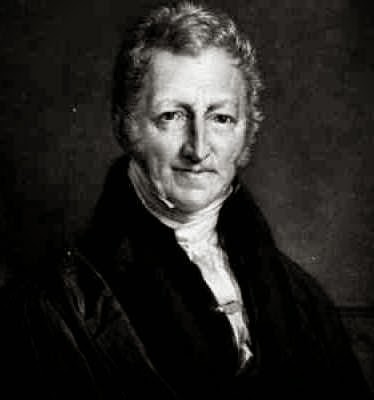 |
| Thomas Malthus |
 |
| Herbert Spencer |
The publication of Ernst Haeckel's best-selling 'Welträtsel' ('Riddle of the Universe') in 1899 brought social Darwinism, and earlier ideas of racial hygiene, to a wider audience.
His recapitulation theory was not Darwinism, but rather attempted to combine the ideas of Goethe, Lamarck and Darwin.
 |
| Ernst Haeckel |
Ernst Heinrich Philipp August Haeckel (February 16, 1834 – August 9, 1919), was a German biologist, naturalist, philosopher, physician, professor and artist who discovered, described and named thousands of new species, mapped a genealogical tree relating all life forms, and coined many terms in biology, including anthropogeny, ecology, phylum, phylogeny, stem cell, and the kingdom Protista. Haeckel promoted and popularized Charles Darwin's work in Germany and developed the recapitulation theory ("ontogeny recapitulates phylogeny") claiming that an individual organism's biological development, or ontogeny, parallels and summarizes its species' evolutionary development, or phylogeny.The published artwork of Haeckel includes over 100 detailed, multi-colour illustrations of animals and sea creatures ('Kunstformen der Natur' -, "Art Forms of Nature"). As a philosopher, Ernst Haeckel wrote 'Die Welträtsel' (1895–1899, 'The Riddle of the Universe-, 1901), the genesis for the term "world riddle" (Welträtsel).
“To be modern only means to fill new forms with eternal truths.” – Joseph Goebbels
 |
| Phidias - Ingres |
 |
| Parthenon - South Metope 27 - Phidias |
Models from antiquity and the Renaissance were adapted to the prevailing spirit of the times.
Numerous German sculptors worked on such artistic projects, while benefiting from the logistic and financial support of the National Socialist political elite.
Their sculptures resembled, either by form, or by composition, the works of Praxiteles or of Phidias of ancient Greece, or those executed by Michelangelo during the Renaissance.
The most prominent German sculptors in the Third Reich were Arno Breker, Josef Thorak, and Fritz Klimsch, who although enjoying the support of the National Socialist regime, were never members of the NSDAP.
Numerous German sculptors worked on such artistic projects, while benefiting from the logistic and financial support of the National Socialist political elite.
 |
| Lo Schiavo Morente Michelangelo |
The most prominent German sculptors in the Third Reich were Arno Breker, Josef Thorak, and Fritz Klimsch, who although enjoying the support of the National Socialist regime, were never members of the NSDAP.
 |
| Bereitschaft - Arno Breker |
Arno Breker (July 19, 1900 – February 13, 1991) was a German sculptor, best known for his public works in the Third Reich, which were endorsed by the authorities as the antithesis of degenerate art. The neoclassical nature of his work, with titles like Comradeship, Torchbearer, and Sacrifice, typified National Socialist ideals, and suited the characteristics of National Socialist architecture
On closer inspection, though, the proportions of his figures, the highly colouristic treatment of his surfaces (the strong contrasts between dark and light accents), and the melodramatic tension of their musculatures perhaps invites comparison with the Italian Mannerist sculptors of the 16th century. Stylistically, Mannerism encompasses a variety of approaches influenced by, and reacting to, the ideals associated with artists such as Leonardo da Vinci, Raphael, and Michelangelo. While High Renaissance explored harmonious ideals, Mannerism wanted to go a step further. Mannerism is notable for its intellectual sophistication, as well as its artificial (as opposed to naturalistic) qualities. Mannerism favours compositional tension and instability, rather than the balance and clarity of early Renaissance.
Mannerist Sculpture
Philopoemen
David d'Angers
Josef Thorak (7 February 1889 in Salzburg, Austria – 26 February 1952 in Hartmannsberg, Bavaria) was an Austrian-German sculptor. In 1922, Thorak's reputation increased when he created 'Der sterbende Krieger' (The Dead Warrior), a statue in memory to the dead of World War I of Stolpmünde.
Male and Female Nude
Josef Thorak
In 1933 and in following years, Thorak joined Arno Breker as one of the two "official sculptors" of the Third Reich. In his studio outside Munich, Thorak worked on statues intended to represent the Volksleben of the Third Reich; these works tended to be heroic in scale, up to 65 feet (20 meters) in height. His official works from this period included a number of sculptures at the Berlin Olympic Stadium of 1936.
Fritz Klimsch (10 February 1870, Frankfurt am Main – 30 March 1960, Freiburg) was a German sculptor.
Merkur - Fritz Klimsch
Klimsch studied at the königlich Hochschule für akademische Kunst in Berlin, and was then a student of Fritz Schaper. In 1898 Klimsch was a founding member of the Berlin Secession. In the era of National Socialism Klimsch was highly regarded as an artist, and created busts of Erich Ludendorff, Wilhelm Frick and Adolf Hitler. According to a diary entry by Goebbels, Klimsch was 'the most mature of our sculptors. A genius.' In September 1944 Klimsch was named in the highest rank of artists of the Third Reich, in the Gottbegnadeten list.
“Those who have a beautiful physique should be brought into the foreground, so that they might encourage the development of a beautiful bodily form among the people in general.”
Adolf Hitler
 |
| Immanuel Kant |
Immanuel Kant the aesthetic experience of beauty is a judgement of a subjective but similar human truth, since all people should agree that "this rose is beautiful" if it in fact is.
 |
| Friedrich Schiller |
For Friedrich Wilhelm Joseph Schelling, the philosophy of art is the "organon" of philosophy concerning the relation between man and nature.
Friedrich von Schlegel, August Wilhelm Schlegel, Friedrich Schleiermacher and Georg Wilhelm Friedrich Hegel have also given lectures on aesthetics as philosophy of art after 1800.
 |
| Georg Wilhelm Friedrich Hegel |
'Art is the first stage in which the 'absolute spirit' is manifest immediately to sense-perception, and is thus an objective rather than subjective revelation of beauty'.
 |
| Arthur Schopenhauer |
It is thus for Schopenhauer one way to fight the suffering.
Later, Adolf Hitler placed much emphasis on 'Aryan aesthetics' as a way to unite people and give them sense of purpose, thereby turning them into a 'volk'.
Æsthetics (also spelled aesthetics) is a branch of philosophy, dealing with the nature of art, beauty, and taste, and with the creation and appreciation of beauty.It is more scientifically defined as the study of sensory or sensori-emotional values, sometimes called judgements of sentiment.
 |
| Discobolus |
 |
| Olympian Apollo |
This period of Greek art saw a veneration of the human physical form and the development of corresponding skills to show musculature, poise, beauty and anatomically correct proportions.
Furthermore, in many Western and Eastern cultures alike, traits such as body hair are rarely depicted in art that addresses physical beauty.
In contrast with this Greek-Western aesthetic taste is the non-Aryan genre of the grotesque.
Greek philosophers initially felt that aesthetically appealing objects were beautiful in and of themselves.
Plato believed that for us to have a perception of beauty there must be a transcendent form for beauty, in which beautiful objects partake, and which causes them to be beautiful also.
He felt that beautiful objects incorporated proportion, harmony, and unity among their parts.
Similarly, in the 'Metaphysics', Aristotle found that the universal elements of beauty were order, symmetry, and definiteness.
 |
| Bäuerliche Venus - 1939 Sepp Hilz 'Pornographic Art ?' |
A large number of paintings and other works of art executed during the Third Reich were either removed or destroyed.
Several hundred sculptures were destroyed during the Allied air bombardments.
After the war, a considerable number of works of art were confiscated by the Americans, because of their supposedly “pornographic character.”
In the spring of 1947, 8,722 paintings and sculptures of German artists were transported to the United States.
Of these, only a small number have been returned to the Federal Republic of Germany.
Der arische Nordic Rasse
The Nordic race was one of the sub-races into which late 19th to mid 20th century anthropologists divided the Caucasian race.
People of the Nordic type are described as usually having light-colored hair, light-colored eyes, fair skin, long and narrow skulls and tall stature, and are considered to predominate in the countries of Northern Europe.
The psychological traits of Nordics were described as truthful, equitable, competitive, naïve, reserved and individualistic.
Other, similar European sub-races are the Alpine race, Dinaric race, East Baltic race and the Mediterranean race.
Nordicism is an ideology of racial separatism which views Aryan Nordics as an endangered racial group, as identified by Madison Grant in 'The Passing of the Great Race'.
This ideology was popular in the late 19th and early 20th centuries in some Central and Northern European countries, as well as in North America.
National Socialists claim that the "Aryan Nordic race" within the greater Caucasian race, constituted a 'master race' or 'Herrenvolk' (see above).
In the mid 19th century, scientific racial theories developed the concept of Aryanism, holding that Europeans ("Aryans") were an innately superior branch of humanity, responsible for most of its greatest achievements.
Aryanism was derived from the idea that the original speakers of the Indo-European languages constituted a distinctive race or sub-race of the larger Caucasian race.
 |
| Arthur de Gobineau |
Though Gobineau argued that Germanic people were the best modern representatives of the Aryan race.
Adapting the comments of Tacitus and other Roman writers, he argued that "pure" Northerners regenerated Europe after the Roman Empire declined, due to racial "dilution" of its leadership.
By the 1880s a number of linguists and anthropologists argued that the Aryans themselves had originated somewhere in northern Europe.
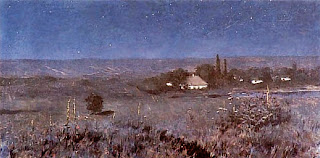 |
| The Ukraine |
The biologist Thomas Henry Huxley agreed with him, coining the term "Xanthochroi" to refer to fair-skinned Europeans, as opposed to darker Mediterranean peoples, whom Huxley called "Melanochroi".
It was Huxley who also concluded that the Melanochroi (Peoples of the Mediterranean race), who he described as "dark whites", are of a mixture of the Xanthochroi and Australioids.
This distinction was repeated by Charles Morris in his book 'The Aryan Race' (1888), which argued that the original Aryans could be identified by their Nordic features, such as dolichocephaly (long skull).
The argument was given extra impetus by the French anthropologist Vacher de Lapouge in his book 'L’Aryen', in which he argued that the "dolichocephalic" peoples were natural leaders, destined to rule over more brachycephalic (short-skulled) peoples.
The philosopher Friedrich Nietzsche also referred in his writings to "blond beasts": amoral adventurers who were supposed to be the progenitors of creative cultures.
In 'On the Genealogy of Morals' (1887), he wrote, "In Latin malus ... could indicate the vulgar man as the dark one, especially as the black-haired one, as the pre-Aryan dweller of the Italian soil which distinguished itself most clearly through his color from the blonds who became their masters, namely the Aryan conquering race."
Defining Characteristics
Henry Keane's 'Man, Past and Present' (1899) shows a Dane as an example of the Nordic type
It was the Russian-born French anthropologist Joseph Deniker that initially proposed "nordique" (meaning simply "northern") as an "ethnic group" (a term that he coined).
He defined ''nordique' by a set of physical characteristics: The concurrence of fair, somewhat wavy hair, light eyes, reddish skin, tall stature and a dolichocephalic skull.
Of six 'Caucasian' groups Deniker accommodated four into secondary ethnic groups, all of which he considered intermediate to the Nordic: Northwestern, Sub-Nordic, Vistula and Sub-Adriatic, respectively.
American economist William Z. Ripley defined scientifically a "Teutonic Race" (teutonische Rasse) in his book 'The Races of Europe' (1899).
He divided Europeans into three main subcategories: Teutonic (teutonisch), Alpine and Mediterranean.
According to Ripley the "Teutonic race" resided in Scandinavia, north Germany, Baltic states and East Prussia, north Poland, north Russia, Britain, Ireland, parts of Central Europe and was typified by light hair, light skin, blue eyes, tall stature, a narrow nose, and slender body type.
Georges Vacher de Lapouge had called this race "Homo Europaeus".
Madison Grant, in his book 'The Passing of the Great Race', took up Ripley's classification. He described a "Nordic" type as "long skulled, very tall, fair skinned, with blond or brown hair and light colored eyes.
The Nordics inhabit the countries around the North and Baltic Seas and include not only the great Scandinavian and Teutonic groups, but also other early peoples who first appear in southern Europe and in Asia as representatives of Aryan language and culture."
According to Grant, the "Alpine race", shorter in stature, darker in coloring, with a rounder head, predominated in Central and Eastern Europe through to Turkey and the Eurasian steppes of Central Asia and Southern Russia.
The "Mediterranean race", with dark hair and eyes, aquiline nose, swarthy complexion, moderate-to-short stature, and moderate or long skull was said to be prevalent in Southern Europe, the Middle East, and North Africa.
By 1902 the German archaeologist Gustaf Kossinna identified the original Aryans (Proto-Indo-Europeans) with the north German Corded Ware culture, an argument that gained in currency over the following two decades.
He placed the Indo-European Urheimat in Schleswig-Holstein, arguing that they had expanded across Europe from there.
By the early 20th century this theory was well established.
Sociologists were soon using the concept of a "Aryan (or Nordic) race" to model the migrations of the more entrepreneurial and innovative components of European populations.
In 1939 Carleton Coon wrote that "The Poles who came to the United States during the 19th century, and the early decades of the 20th, did not represent a cross-section of the Polish population, but a taller, blonder, longer-headed group than the Poles as a whole."
The apposite "high brow"/"low brow" distinction, derived from such theories, also became enshrined in language.
It was the already mentioned work of sociologist/economist William Z. Ripley which popularized the idea of three biological European races.
Ripley borrowed Deniker's terminology of Nordic (he had previously used the term "Teuton"); his division of the European races relied on a variety of anthropometric measurements, but focused especially on their cephalic index and stature.
Compared to Deniker, Ripley advocated a simplified racial view and proposed a single Teutonic race linked to geographic areas where Nordic-like characteristics predominate, and contrasted these areas to the boundaries of two other types, Alpine and Mediterranean, thus reducing the Caucasoid branch of humanity' to three distinct groups.
By the early 20th century, Ripley's tripartite Nordic/Alpine/Mediterranean model was well established.
Most 19th century racial-theorists, like Arthur de Gobineau, Otto Ammon, Georges Vacher de Lapouge and Houston Stewart Chamberlain, preferred to speak of "Aryans," "Teutons," and "Indo-Europeans" instead of "Nordic Race".
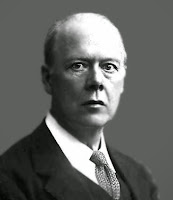 |
| Houston Stewart Chamberlain |
Chamberlain's ideas would later influence Adolf Hitler, and National Socialist ideology.
Only in the 1920s did a strong partiality for "Nordic" begin to reveal itself, and for a while the term was used almost interchangeably with Aryan.
Later, however, Nordic would not be co-terminous with Aryan, Indo-European or Germanic.
For example, the minister for Food in the Third Reich, Richard Walther Darré, who had developed a concept of the German peasantry as Nordic race, used the term 'Aryan' to refer to the tribes of the Iranian plains.
Hans Günther
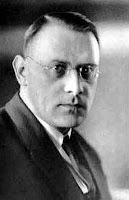 |
| Hans F. K. Günther |
This work was influential in Ewald Banse's publication of 'Die Rassenkarte von Europa' in 1925 which combined research by Joseph Deniker, William Z. Ripley, Madison Grant, Otto Hauser, Hans F. K. Günther, Eugen Fischer and Gustav Kraitschek.
In 'The Racial Elements of European History' Gunther further identified a race he named 'Hither Asiatic' in Southern Spain and Morocco, which he believed was carried into Europe through the Moorish invasions.
He identified an 'Inner Asiatic', race residing in Northern Scandinavia and Northern Russia. He also identified the 'Oriental race', residing and originating from Arabia, as well as the Near Asiatic race originating from Persia.
Der Herrenrasse
By the early twentieth century the concept of a "masterly" Nordic race had become familiar enough that the British psychologist William McDougall, writing in 1920, stated:
'Among all the disputes and uncertainties of the ethnographers about the races of Europe, one fact stands out clearly - namely, that we can distinguish a race of northerly distribution and origin, characterized physically by fair color of hair and skin and eyes, by tall stature and dolichocephaly (i.e. long shape of head), and mentally by great independence of character, individual initiative and tenacity of will. Many names have been used to denote this type, ... . It is also called the Nordic type.'
Nordicists claim that Nordics had formed upper tiers of ancient civilizations, even in the Mediterranean civilizations of antiquity, which had declined once this dominant race had been assimilated.
Thus they argued that ancient evidence suggested that leading Romans like Sulla and Cato were blond or red-haired.
Some Nordicists admitted the Mediterranean race possessed considerable artistic ability., however, the Nordic race was regarded as superior on the basis that, although Mediterranean peoples were culturally sophisticated, it was the Nordics who were alleged to be the innovators and conquerors, having an adventurous spirit that no other race could match.
The Alpine race was usually regarded as inferior to both the Nordic and Mediterranean races, making up the traditional peasant class of Europe while Nordics occupied the aristocracy and led the world in technology.
Völkischen Rassenlehre in Deutschland
In German speaking countries Nordicism was known under the term "Nordischer Gedanke" (Nordic thought).
This phrase was coined by the German eugenicists Erwin Baur, Eugen Fischer and Fritz Lenz.
It appeared in their 1921 work 'Menschliche Erblehre' (Human Heredity), which described the innate superiority of the Nordic race.
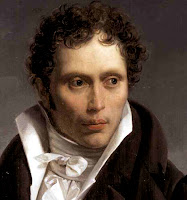 |
| Arthur Schopenhauer |
 |
| Charles Darwin |
This had ensured that weaker individuals had not survived.
This argument was derived from earlier eugenicist and Social Darwinist ideas.
According to the authors, the Nordic race arose in the ice age, from: 'quite a small group which, under stress of rapidly changing conditions (climate, beasts of the chase) was exposed to exceptionally rigorous selection and was persistently inbred, thus acquiring the peculiar characteristics which persist today as the exclusive heritage of the Nordic race ... Philological, archaeological and anthropological researches combine to indicate that the primal home of the Indo-Germanic [i.e. Aryan] languages must have been in Northern Europe.'
They went on to state that "the original Indo-Germanic civilisation" was carried by Nordic migrants down to India, and that the physiognomy of upper caste Indians "disclose a Nordic origin".
By this time, Germany was well-accustomed to theories of race, and racial superiority, due to the long presence of the Völkish movement, the philosophy that Germans constituted a unique people, or volk, linked by common blood.
While Volkism was extremely popular, and was a version of ethnic nationalism, 'Nordicism' attracted German anthropologists and eugenicists.
Hans F. K. Günther, one of Fischer's students, first defined "Nordic thought" in his programmatic book 'Der Nordische Gedanke unter den Deutschen'
He became the most influential German in this field.
His 'Short Ethnology of the German People' (1929) was very widely circulated.
In his 'Rassenkunde des deutschen Volkes' (Race-Lore of the German Volk), published 1922, Günther identified five principal European races instead of three, adding the East Baltic race and Dinaric race to Ripley's categories.
He used the term Ostic (easttern) instead of Alpine, and he focused on various races' distinct mental attributes.
Many Völkists who merged Völkism and Nordicism embraced Günther's ideas, most notably the National Socialists
Adolf Hitler read 'Human Heredity' shortly before he wrote 'Mein Kampf', and condidered it scientific proof of the racial basis of civilisation.
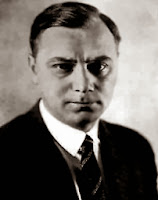 |
| Alfred Rosenberg |
National Socialists held the Atlanteans to be a race of Nordic 'supermen', and Alfred Rosenberg wrote of a "Nordic-Atlantean" 'herren volk' (master race), whose civilization was lost through inward corruption and betrayal.
 |
| Atlantis |
Like Grant and others, he argued that the entrepreneurial energy of the Nordics had "degenerated" when they mixed with "inferior" peoples.
With the rise of National Socialism, Nordic theory became the norm within German culture.
In some cases the "Nordic" concept became an almost abstract ideal rather than a mere racial category.
Hans F. K. Günther, who joined the Nazi Party in 1932, was praised as a pioneer in racial thinking, a shining light of Nordic theory.
Most official comments, in the Third Reich, on the Nordic Race, were based on Günther's works, and Alfred Rosenberg presented Günther with a medal for his work g the policy of Racial Hygiene.
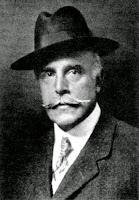 |
| Madison Grant |
Günther's work agreed with Grant's, and the German anthropologist frequently stated that the Germans are in many ways not a fully Nordic people.
Hitler himself was later to downplay the importance of Nordicism (as opposed to Aryanism) in public for this very reason.
National Socialist legislation identifying the ethnic and "racial" affinities of the Jews reflects the populationist concept of race. Discrimination was not restricted to Jews who belonged to the "Oriental-Armenoid" race, but was directed against all members of the Jewish ethnic population.
By 1939 Hitler had abandoned Nordicist rhetoric in favor of the idea that the German people as a whole were united by distinct "Aryan spiritual" qualities.
Nevertheless, Third Reich eugenics policies continued to favor Nordics over Alpines and other racial groups, particularly during the war when decisions were being made about the incorporation of conquered peoples into the Reich.
In 1942 Hitler stated in private,
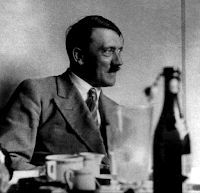 |
| Adolf Hitler |
'I shall have no peace of mind until I have planted a seed of Nordic blood wherever the population stand in need of regeneration. If at the time of the migrations, while the great racial currents were exercising their influence, our people received so varied a share of attributes, these latter blossomed to their full value only because of the presence of the Nordic racial nucleus.'
Hitler and Himmler planned to use the SS as the basis for the racial "regeneration" of Europe following the final victory of Nationaal Socialism.
The SS was to be a 'racial elite', chosen on the basis of "pure" Nordic Aryan qualities.
Addressing officers of the 'Leibstandarte - SS Adolf Hitler' Himmler stated:
 |
| Leibstandarte - SS Adolf Hitler |
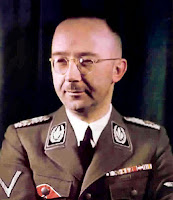.jpg) |
| Reichsfuehrer SS Himmler |
'The ultimate aim for those 11 years during which I have been the Reichsfuehrer SS has been invariably the same: to create an order of good blood which is able to serve Germany; which unfailingly and without sparing itself can be made use of because the greatest losses can do no harm to the vitality of this order, the vitality of these men, because they will always be replaced.
To create an order which will spread the idea of Nordic Aryan blood so far that we will attract all Nordic Aryan blood in the world, take away that blood from our adversaries, absorb it so that never again, looking at it from the viewpoint of grand policy, will our adverseries fight against us.'
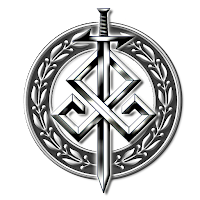 |
| © Copyright Peter Crawford 2015 |
Hitler, Rasse und das Okkulte
Indeed, the composer Richard Wagner, the philosophers Friedrich Nietzsche and Arthur Schopenhauer, the racial philosophers Joseph Arthur Gobineau and Houston Stewart Chamberlain, extreme nationalism, Social Darwinism, and völkisch racism in general are all regularly cited as his main sources.
Since Hitler rarely specified his sources, scholars have resorted to indicating similarities and parallels in order to document these influences.
The suggestion made in the 1950s by Joachim Besser, and in the early 1960s by George Mosse, that an examination of the impact of occult or esoteric philosophies, especially current in Vienna and Munich in the late nineteenth and early twentieth centuries, on Hitler and early National Socialism might indeed be a more fruitful line of approach to the problem, has not been widely pursued by academic historians.
Recently, however, Jeffrey Goldstein and James Webb have emphasized the importance of occultism in general in the emergence of Nazi ideology, and it is now plainly evident that occult or esoteric racial philosophy may, indeed, have been one of the major sources for Hitler's racial ideology.
Hitler himself may have been partly responsible for leading historians away from investigating esoteric influences.
It is well known that Hitler criticized occultists, Freemasons, and astrologers, and even persecuted some of them when he came into power.
And yet, in his nightly monologues to his assembled guests, Hitler revealed his belief in the very ideas that these groups were perpetrating.
Ample evidence of this is provided in his references to reincarnation, the lost continent of Atlantis, and Hanns Hörbiger's world ice theory, as well as in his conviction that the early myths and legends of cosmic disasters and struggles between giants and gods are actually mankind's vague memory of a disaster that destroyed a humanity that already possessed an advanced degree of civilization.
A large variety of occult or esoteric groups and philosophies existed in German-speaking lands from the 1890s into the 1920s.
 |
| Seal of the Theosophical Society © Copyright Peter Crawford 2013 |
 One of the most influential schools of thought came out of the work established by the Russian Helena Blavatsky.
One of the most influential schools of thought came out of the work established by the Russian Helena Blavatsky.Blavatsky, who had immersed herself deeply in esoteric spiritual beliefs from all over the world, formed a universal esoteric philosophy which she called 'Theosophy' (Wisdom of the Gods).
She viewed it as the revival of an ancient, occult knowledge derived from an earlier, advanced civilization which had known a unity between science and religion.
After the establishment of the first Theosophic lodge in 1884 in Germany, the movement spread rapidly in that country.
click below for more information about
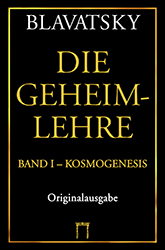 |
| 'Die Geheimlehre' |
According to Blavatsky, there are seven root races of mankind, with each root race containing seven sub-races.
 |
| The Fifth Root Race © Copyright Peter Crawford 2014 |
According to Hitler:
"Creation is not yet at an end.... Man has clearly arrived at a turning point.... A new variety of man is beginning to separate out."Hitler further believed that mankind would evolve into two distinct types:
"The two types will rapidly diverge from one another. One will sink to a sub-human race and the other rise far above the man of today. I might call the two varieties the god- man and the mass-animal."To Hitler, it was the divine mission of National Socialism to bring this about:
"Those who see in National Socialism nothing more than a political movement know scarcely anything of it. It is more even than a religion: it is the will to create mankind anew."To accomplish this Hitler believed that National Socialism must return the Aryan to his original state, for example, oneness with 'Volk', racial purity, and inner spirituality.
If the völkisch movement was to lead the Aryan race back to its purest form, it must, Hitler felt, eliminate those factors that caused it to stray in the first place.
These are the intellect, egoism, materialism, and impurity of blood.
The existence of these elements was not, in Hitler's mind, an accident of Aryan evolution, but the result of the conspiratorial actions lesser races.
This dualism between the Aryan and the lesser races - particularly the Jews - is dramatically echoed in Hitler in the following passage:
"Two worlds face one another-the men of God and the men of Satan. The Jew is the anti-man, the creature of another god. He must have come from another root of the human race. I set the Aryan and the Jew over against each other; and if I call one of them a human being I must call the other something else. He is a creature outside nature and alien to nature."In a 1931 interview with a Leipzig newspaper editor, Adolf Hitler made a passionate declaration of the true significance of his National Socialist movement:
Houston Stewart Chamberlain 'The Frenchman Gobineau, and the Englishman Chamberlain, were inspired by our concept of a new order - or if you prefer, an ideological glimpse into history in accordance with the basic principle of the blood.We do not judge by merely artistic or military standards, or even by purely scientific ones.We judge by the spiritual energy which a people is capable of putting forth, which will enable it in ten years to recapture what it has lost in a thousand years of warfare.I intend to set up a thousand year Reich, and anyone who supports me in battle is a fellow-fighter for a unique spiritual - I would almost say divine-creation.At the decisive moment the decisive factor is not the ratio of strength but the spiritual force employed.Betrayal of the nation is possible even when no crime has been committed, in other words when a historical mission has not been fulfilled.'
Arthur de Gobineau
 |
| click here for THE ILLUSTRATED MEIN KAMPF © Copyright Peter Crawford 2014 |
"The racial question gives the key not only to world history, but to all human culture."
'Mein Kampf'
Race was not simply a political issue to be used to curry the favor of the masses, but the "granite foundation" of Hitler's ideology.
Hitler's racial ideology stemmed from what he called "the basic principle of the blood."
This meant that the blood of every person, and every race, contained the soul of a person, and likewise the soul of his race, the Volk.
Hitler believed that the Aryan race, to which all "true" Germans belonged, was the race whose blood (soul) was of the highest degree.
God Himself had, in fact, created the Aryans as the most perfect men, both physically and spiritually.
Since the blood (soul) of the Aryans contained specific spiritual energies, the "cultural energies", or "racial primal elements," as Hitler often called them, the Aryans supplied the culture that creates the beauty and dignity of higher humanity.
In other words, all that man calls higher culture (see below) was ultimately the product of the spiritual and creative energies that exist in the blood of the Aryans.
Hitler stated:
Germany's loss of World War I, and subsequent economic problems were the visible contemporary evidence of Aryan decline.
This descent occurred by the original error of the contamination of the Aryan blood (soul) by inferior races:
The Aryans, according to Hitler, were once rulers of the earth, the highest race of mankind, endowed with the highest degree of spiritual qualities, and the only ones capable of producing a higher civilization.
Aryans were, in essence, 'god-men' on earth, but through racial mixing, lost their ruling position.
However, as its "higher mission," the German people were destined to regain this position for the Aryan race.
To do so, Germany must restructure its political and social foundations, and create a state whose function was to promote the Aryan culture creating "spiritual elements" that exist in the blood of the German race.
If this were done, racially and thus spiritually pure human beings could be produced, ensuring full development of the Aryan race.
Then Germany would be able to produce pure Aryans, who would be physically and spiritually perfect human beings.
And thus Hitler's 'new order' would be established, with spiritually pure Aryans, 'demigod rulers', who, as Hitler enigmatically but significantly expressed it:
"National Socialism," he once stated:
Perhaps Hitler's most perceptive and significant, yet little known statement was that the purpose of human evolution was
This doctrine of 'transformationism' dates back nearly 6,000 years, finding its crucible in Mesopotamia.
It was the religious doctrine promulgated by the ancient Babylonian, Egyptian and Hellenistic Mystery cults.
The evolution of man into 'superman' - was always the purpose of the Ancient Mysteries, and it comes as little surprise that the philosopher Nietzsche viewed the gods of the Bacchic and Dionysian Mysteries so favorably.
They embodied his faith in humanity's emergent deity.
Likewise, Hitler adhered to the religion of 'apotheosized man'.
In order to create the Übermensch - the 'god-man', Hitler believed that he required a racial foundation - and that was 'die Herrenrasse' (the Master Race).
It is very important to note that the 'Übermensch' and 'Herrenrasse' are not identical, and the former must be built on the latter.
The concept of the 'Herrenrasse' is purely biological, whereas the concept of the 'Übermensch' is occult.
The 'Herrenvolk' was fundementaly the 'Aryan Nordic race' and the 'Herrenvolk' was the foundation from which the 'God-man' would be created.
And the Übermensch is the aim and purpose of Creation.
The concept of racial beauty in ancient Greece or during the Renaissance in the 15th century Italy was often used as a pedagogical and graphic tool to provide the sense of order and form (Gestalt).
Hitler's racial ideology stemmed from what he called "the basic principle of the blood."
This meant that the blood of every person, and every race, contained the soul of a person, and likewise the soul of his race, the Volk.
Hitler believed that the Aryan race, to which all "true" Germans belonged, was the race whose blood (soul) was of the highest degree.
God Himself had, in fact, created the Aryans as the most perfect men, both physically and spiritually.
Since the blood (soul) of the Aryans contained specific spiritual energies, the "cultural energies", or "racial primal elements," as Hitler often called them, the Aryans supplied the culture that creates the beauty and dignity of higher humanity.
In other words, all that man calls higher culture (see below) was ultimately the product of the spiritual and creative energies that exist in the blood of the Aryans.
Hitler stated:
Indeed, this dying-off of the Aryans was what Adolf Hitler perceived as happening around him.'All the human culture, all the results of art, science, and technology that we see before us today, are almost exclusively the creative product of the Aryan. This very fact admits of the not unfounded inference that he alone was the founder of all higher humanity, therefore representing the prototype of all that we understand by the word "man." He is the Prometheus of mankind from whose bright forehead the divine spark of genius has sprung at all times.... Exclude him- -and perhaps after a few thousand years darkness will again descend on the earth, human culture will pass, and the world turn to a desert. Human culture and civilization on this continent are inseparably bound up with the presence of the Aryan. If he dies out or declines, the dark veils of an age without culture will again descend on this globe.'
'Genius des Siegers'
Germany's loss of World War I, and subsequent economic problems were the visible contemporary evidence of Aryan decline.
This descent occurred by the original error of the contamination of the Aryan blood (soul) by inferior races:
'The Aryan gave up the purity of his blood and, therefore, lost his sojourn in the paradise which he had made for himself. He became submerged in the racial mixture, and gradually, more and more, lost his cultural capacity, until at last, not only mentally but also physically, he began to resemble the subjected aborigines more than his own ancestors.... Thus cultures and empires collapsed to make place for new formations. Blood mixture and the resultant drop in the racial level is the sole cause of the dying out of old cultures; for men do not perish as a result of lost wars, but by the loss of that force of resistance which is contained only in pure blood. All who are not of good race in this world are chaff.'
'Nach dem Kampf'
Hans Bühler
'The state, National Socialists stated, is a means to an end.Its end lies in the preservation and advancement of a community of physically and psychically homogeneous creatures.This preservation itself comprises first of all existence as a race and thereby permits the free development of all the forces dormant in this race....Thus, the highest purpose of the völkisch state is concern for the preservation of those original racial elements which bestow culture and create the beauty and dignity of a higher mankind.We, as Aryans, can conceive of the state only as the living organism of a nationality which not only assures the preservation of this nationality, but by the development of its spiritual and ideal abilities leads it to the highest freedom.'Hitler often spoke of an "historic" or "higher mission" of the Aryan race and its elite core, the German people.
The Aryans, according to Hitler, were once rulers of the earth, the highest race of mankind, endowed with the highest degree of spiritual qualities, and the only ones capable of producing a higher civilization.
Aryans were, in essence, 'god-men' on earth, but through racial mixing, lost their ruling position.
However, as its "higher mission," the German people were destined to regain this position for the Aryan race.
To do so, Germany must restructure its political and social foundations, and create a state whose function was to promote the Aryan culture creating "spiritual elements" that exist in the blood of the German race.
 |
| 'physically and spiritually perfect human beings' © Copyright Peter Crawford 2014 |
Then Germany would be able to produce pure Aryans, who would be physically and spiritually perfect human beings.
And thus Hitler's 'new order' would be established, with spiritually pure Aryans, 'demigod rulers', who, as Hitler enigmatically but significantly expressed it:
"having achieved possession of this earth, will have a free path for activity in domains which will lie partly above it and partly outside it."This last statement is a reminder that Hitler suggested on occasion that there was a deeper, cosmic significance to his 'new order'.
"National Socialism," he once stated:
"would be worth nothing if it were restricted merely to Germany and did not seal the supremacy of the superior Race over the entire world for at least a thousand to two thousand years."Even in Mein Kampf, Hitler hinted that such a master race would have to make "the last and greatest decisions on this earth."
Perhaps Hitler's most perceptive and significant, yet little known statement was that the purpose of human evolution was
'to achieve a mystic vision of the Universe'.And Hitler knew that this vision - this union with the ultimate - could only be achieved by the race of 'demi-gods and god-men' - and it was this that motivated all the concern about the purity of the Aryan race that formed the essential core of Völkisch philosophy - because only the Aryan 'god-man' could achieve the 'ultimate purpose of creation'.
This doctrine of 'transformationism' dates back nearly 6,000 years, finding its crucible in Mesopotamia.
It was the religious doctrine promulgated by the ancient Babylonian, Egyptian and Hellenistic Mystery cults.
The evolution of man into 'superman' - was always the purpose of the Ancient Mysteries, and it comes as little surprise that the philosopher Nietzsche viewed the gods of the Bacchic and Dionysian Mysteries so favorably.
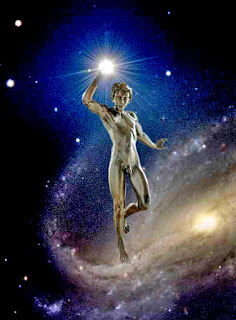 |
| © Copyright Peter Crawford 2015 |
Likewise, Hitler adhered to the religion of 'apotheosized man'.
"Man is becoming God - that is the simple fact. Man is God in the making".
Hitler
It is very important to note that the 'Übermensch' and 'Herrenrasse' are not identical, and the former must be built on the latter.
The concept of the 'Herrenrasse' is purely biological, whereas the concept of the 'Übermensch' is occult.
The 'Herrenvolk' was fundementaly the 'Aryan Nordic race' and the 'Herrenvolk' was the foundation from which the 'God-man' would be created.
And the Übermensch is the aim and purpose of Creation.
click below for more information about
Klassizismus, Bildung und Rasse
The concept of racial beauty in ancient Greece or during the Renaissance in the 15th century Italy was often used as a pedagogical and graphic tool to provide the sense of order and form (Gestalt).
The whole purpose of classicism and neo-classicism, particularly in the fine arts and architecture, but also in philosophy and literature, delineated the rules of perfect racial form and order, and whatever and whoever departs from such order - brings in decadence and death.
Heredity and race are crucial elements in someone’s political and social behavior, but a person possessing the highest qualities of his race - but without a culture that preserves and enhances his race - turns into a biological unit with a meaningless life.
Culture must always come as the final veneer on a person’s racial make-up.
Even among Third Reich scholars the most frequent word was not Rasse (race), but rather the word 'bildung'.
High levels of intelligence, and other positive racial characteristics, can in no way substitute for strong will and moral integrity which is created by 'ausbildung'.
The term 'bildung' refers to the German tradition of self-cultivation (as related to the German for: creation, image, shape), wherein philosophy and education are linked in a manner that refers to a process of both personal and cultural maturation.
This maturation is described as a harmonization of the individual’s mind and heart and in a unification of selfhood and identity within the broader society.
In this sense, the process of harmonization of mind, heart, selfhood and identity is achieved through personal transformation, which presents a challenge to the individual’s accepted beliefs.
In this sense, education involves the shaping of the human being with regard to his/her own humanity as well as his/her innate intellectual skills.
Culture must always come as the final veneer on a person’s racial make-up.
Even among Third Reich scholars the most frequent word was not Rasse (race), but rather the word 'bildung'.
High levels of intelligence, and other positive racial characteristics, can in no way substitute for strong will and moral integrity which is created by 'ausbildung'.
The term 'bildung' refers to the German tradition of self-cultivation (as related to the German for: creation, image, shape), wherein philosophy and education are linked in a manner that refers to a process of both personal and cultural maturation.
This maturation is described as a harmonization of the individual’s mind and heart and in a unification of selfhood and identity within the broader society.
In this sense, the process of harmonization of mind, heart, selfhood and identity is achieved through personal transformation, which presents a challenge to the individual’s accepted beliefs.
In this sense, education involves the shaping of the human being with regard to his/her own humanity as well as his/her innate intellectual skills.
© Copyright Peter Crawford 2015
'The real destiny of Man is something that ordinary men could not conceive and would be unable to comprehend, even if given a glimpse of it.Our revolution is a final stage in an evolution that will end by abolishing history.It is my ultimate aim to perform an act of creation, a divine operation, the goal of a biological mutation which will result in an unprecedented exaltation of the human race and the appearance of a new race of heroes, demi-gods and god-men.The world has reached a turning point, and will undergo an upheaval which the uninitiated cannot understand.'
Adolf Hitler
 |
| © Copyright Peter Crawford 2013 |










